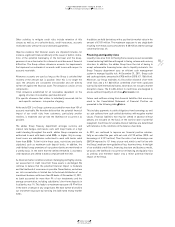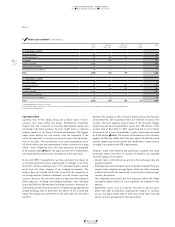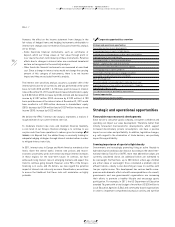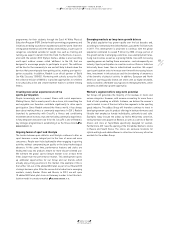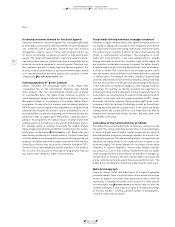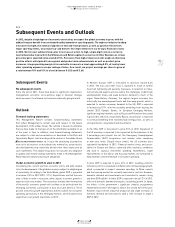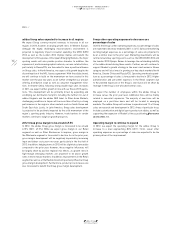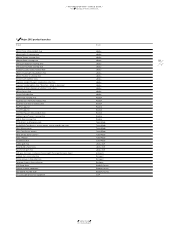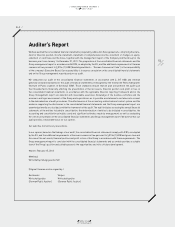Reebok 2011 Annual Report Download - page 167
Download and view the complete annual report
Please find page 167 of the 2011 Reebok annual report below. You can navigate through the pages in the report by either clicking on the pages listed below, or by using the keyword search tool below to find specific information within the annual report.
adidas Group
2011 Annual Report
GROUP MANAGEMENT REPORT – FINANCIAL REVIEW
163
2011
03.5 Subsequent Events and Outlook
Subsequent Events and Outlook
In 2012, despite a high degree of economic uncertainty, we expect the global economy to grow, with the
adidas Group to benefit from continued healthy demand for sporting goods. Through our industry-leading
innovative strength, the extensive pipeline of new and fresh products as well as positive effects from
major sporting events, we project top- and bottom-line improvements in our Group’s financial results
in 2012. We forecast adidas Group sales to increase at a mid- to high-single-digit rate on a currency-
neutral basis due to growth in the Wholesale and Retail segments as well as in Other Businesses. Group
gross margin is expected to be around 47.5%. Pressures from higher input costs will weigh on otherwise
positive effects anticipated from regional and product mix enhancements as well as product price
increases. Group operating margin is forecasted to increase to a level approaching 8.0%, driven by lower
other operating expenses as a percentage of sales. As a result, we project earnings per share to grow at
a rate between 10% and 15% to a level between € 3.52 and € 3.68.
03.5
Subsequent Events
No subsequent events
Since the end of 2011, there have been no significant organisation,
management, economic, socio-political, legal or financial changes
which we expect to influence our business materially going forward.
Outlook
Forward-looking statements
This Management Report contains forward-looking statements
that reflect Management’s current view with respect to the future
develop ment of the adidas Group. The outlook is based on estimates
that we have made on the basis of all the information available to us
at this point in time. In addition, such forward-looking statements
are subject to risks and uncertainties as described in the Risk and
Opportunity Report, which are beyond the control of the adidas Group
SEE RISK AND OPPORTUNITY REPORT, P. 145
. In case the underlying assumptions
turn out to be incorrect or described risks materialise, actual results
and developments may materially deviate from those expressed by
such statements. The adidas Group does not assume any obligation
to update any forward-looking statements made in this Management
Report beyond statutory disclosure obligations.
Global economic growth to slow in 2012
Considering the current political, economic policy and debt-related
risks, the development of the global economy is subject to a high degree
of uncertainty. According to the World Bank, global GDP is projected
to increase 2.5% in 2012 (2011: 2.7%). Expectations are that the euro
area is likely to enter a recession, while Japan’s economic growth is
expected to be very modest. The consensus remains that the majority
of the world’s economic growth will continue to be derived from the
emerging economies, particularly in Asia and Latin America. These
positive economic growth expectations and the outlook for consumer
spending, particularly in the emerging markets, are forecasted to be
supportive to our growth aspirations in 2012.
In Western Europe, GDP is forecasted to decrease around 0.6%
in 2012. The euro area debt crisis is expected to result in further
fiscal belt tightening and austerity measures. A reduction in indus-
trial activity and exports will also add to the challenges of debt, high
unemployment levels and weak domestic demand in much of the
region. Nevertheless, Germany, the region’s largest economy, has
historically low unemployment levels and firm wage growth, which is
expected to sustain consumer demand. In the UK, GDP is expected
to increase by 0.7%, with the economy benefiting from hosting the
London 2012 Olympic Games. In European Emerging Markets,
signifi cant regional markets such as Russia and Poland are forecasted
to grow 3.0% and 2.4%, respectively. Russia, in particular, is expected
to continue benefiting from relatively high energy prices, as well as
strong domestic consumption and investments.
In the USA, GDP is forecasted to grow 2.5% in 2012. Expansion of
the US economy is expected to be supported by the extension of the
2 percentage point payroll tax cut, the Emergency Unemployment
Compensation (EUC) programme and interest rates remaining
at near-zero levels. Despite these stimuli, the US economy faces
substantial headwinds in 2012. Financial market stress and uncer-
tainties in Europe are likely to adversely affect business confidence
and lead to cautious investment spending. Nonetheless, slight
improvements in the labour and housing markets are forecasted to
help maintain some momentum in consumer spending.
In Asia, GDP is expected to grow 4.5% in 2012. Leading economic
indicators point to a slowdown in inflation and continued wage growth,
which is expected to support consumer spending. In China, exports
and the housing market are currently expected to contract. However,
domestic demand and investments are forecasted to remain strong
and drive GDP up 8.6%. In India, GDP is expected to be up 7.2% in 2012,
with solid domestic demand and exports sustaining growth. In Japan,
the effects of the government’s significant stimulus programmes
implemented in 2011 will begin to fade in the second half of the year.
However, export-driven industrial production and slight increases in
domestic demand are forecasted to yield a 1.0% increase in Japan’s
GDP in 2012.




